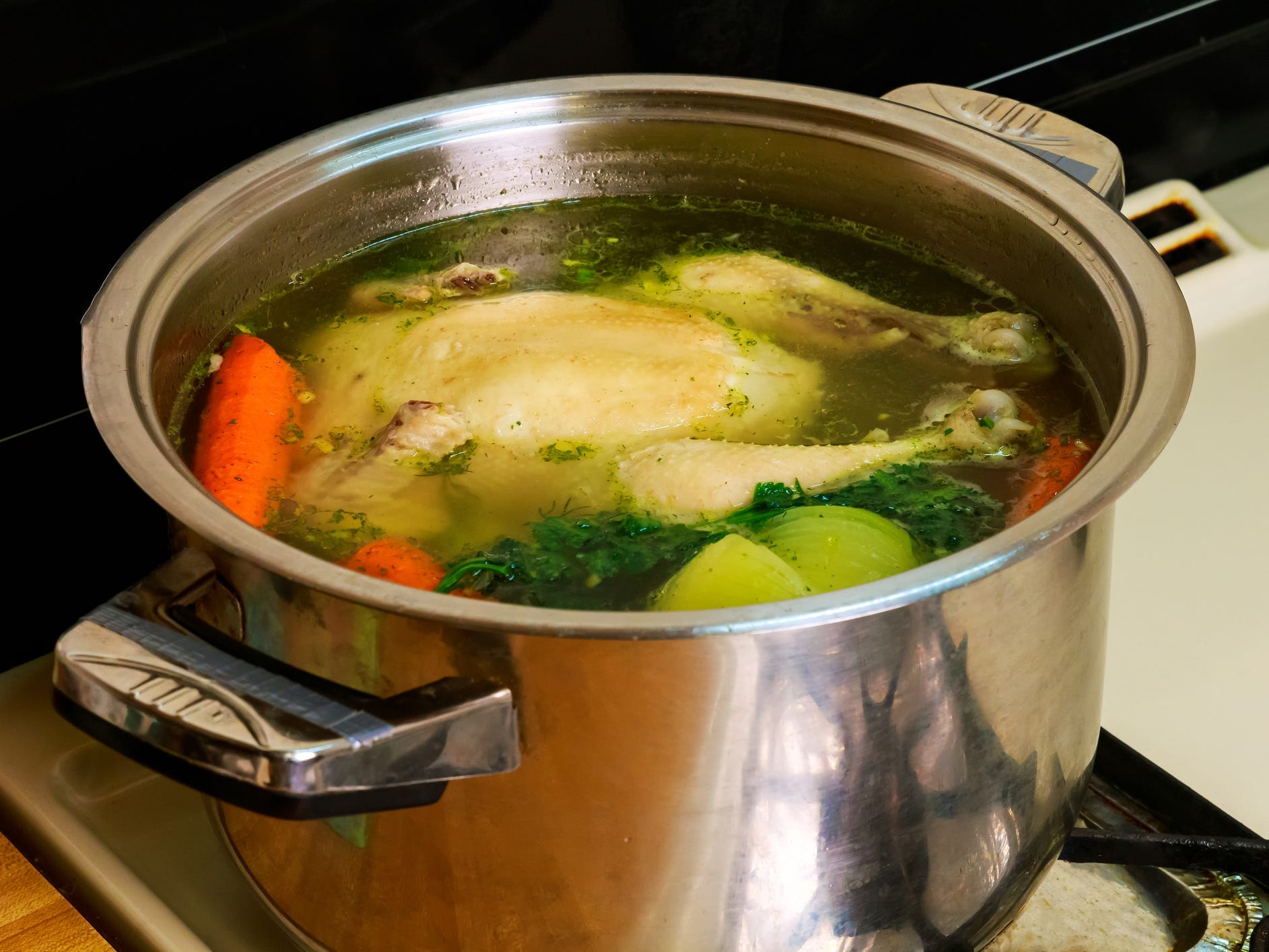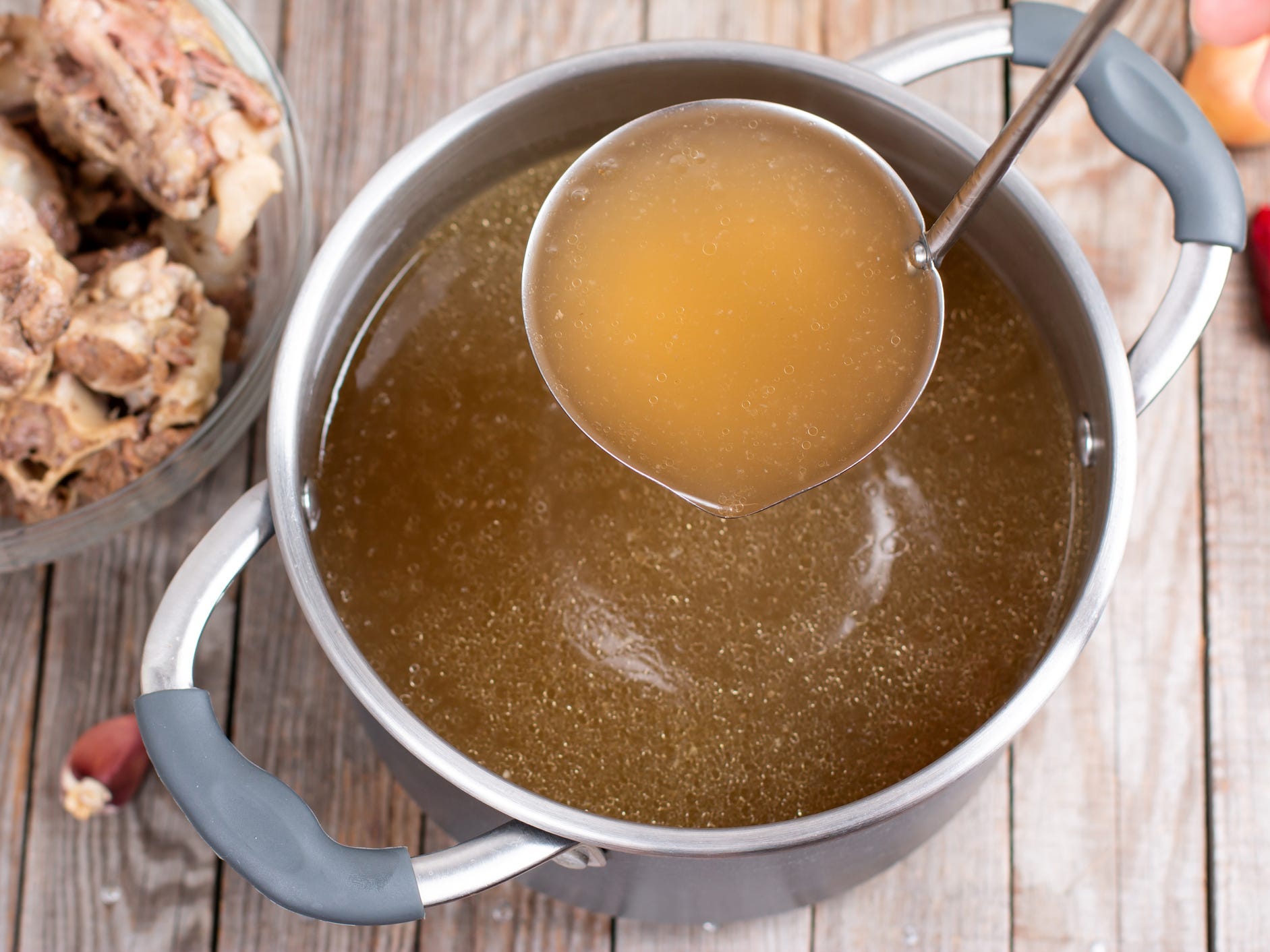
- In most recipes, stock and broth can be used interchangeably, but they differ in ingredients, texture, and seasoning.
- A stock is made from bones and vegetables, while a broth is made from meat and vegetables.
- Broth contains salt and is thinner than stock, so it can be enjoyed on its own.
- Visit Insider's Home & Kitchen Reference library for more stories.
Stock and broth both have their place in the kitchen. While the terms are used interchangeably, and you probably won't notice the difference if you substituted one for the other in a recipe, there are subtle distinctions between the two cooking liquids.
So what sets stock and broth apart, and when might you choose one over the other? The answer depends on your taste buds and what you're cooking.
"I always prefer stock to broth because stock has more body and is more versatile," says Devan Cameron, the chef behind the recipe site Braised and Deglazed. To help you decide for yourself, here are the main differences between stock and broth.
What is stock?
Stock is a cooking liquid that is made by simmering animal bones, vegetables, and herbs in water.
It typically acts as the base for soups and stews, or as a braising liquid for meat and vegetables. Stocks can also be used to cook grains, and to make sauces and gravies.
What makes a stock a stock is the inclusion of bones, which add body and richness. The bones are cooked in water for two to 12 hours to maximize flavor extraction. Cameron says vegetables like onions, carrots, celery, and garlic are added to stock to enhance the flavor.
The most important thing to understand about stock is when animal bones are simmered, collagen is released into the liquid and breaks down into gelatin. This gives stock a thicker consistency with a noticeable mouthfeel.
If homemade stock becomes gelatinous when chilled, that's a good sign. That indicates that the collagen from the bones has turned into gelatin during cooking. "A gelatinous stock adds body, flavor, and nutrition to a sauce," says Cameron.
But there's one thing that's never added to stock: salt. That's because stock is meant to be used as an ingredient to other dishes, and you don't necessarily know how much salt you'll need in future dishes. For example, if you salt your stock and later want to reduce it into a sauce, the reduction will intensify the salt and result in a sauce that's too salty.
Stock can be made from many types of bones. Chicken stock is the most popular, but there are many other types including beef, duck, veal, lobster, or fish stock.
You can keep stock in the fridge for three days, or freeze it in cubes to be used in future dishes.
What is broth?

Broth is any cooking liquid made by simmering meat and vegetables in water. Broth may or may not include bones, but what makes broth different from stock is the addition of meat.
Broth is cooked for less time and can be made in an hour or so. Because collagen is not released during the cooking process — either because of the exclusion of bones or due to the shorter cook time — it doesn't have the same thick texture as stock. The result is a much thinner liquid that does not gel when chilled.
Unlike stocks, which are unseasoned so they can be used in a variety of recipes, broths are seasoned with salt. Because of this, many people consume broth plain. But broth can also be used as a base for soups, sauces, and casserole dishes.
What about bone broth?

Despite its name, bone broth is just a fancy name for stock. It's made by simmering bones for a very long time, usually 24 hours. The focus is on drawing nutrients, not creating the best flavor.
"Chicken stock was invented by French chefs and bone broth was invented by nutritionists," Cameron says.
Stock is focused on purity and flavor — chefs work to keep their stock clear of any fats or impurities. That's less important in bone broth, which is focused on nutritional content.
Read on for the health benefits of bone broth.
Stock and broth are interchangeable
The main difference between stock and broth is how they're made. But stock and broth can usually be substituted for each other.
"Nowadays, even chefs interchange the two terms," Cameron says.
If you're using stock for a soup, you just need to season it to taste, adding herbs or spices. Using broth in place of stock in dishes like gravy or sauces is trickier. You need to be mindful of salt content and not reduce the broth so much that it becomes too salty.
"It may be a little too intense when reduced down into a gravy," Cameron says.
Insider's takeaway
Generally, stock has a thicker consistency and is made by simmering bones, vegetables, and aromatic herbs in water. Unlike stock, broth is made with meat and contains salt. Because of that, broth has a thinner consistency and is richer in flavor.
Bone broth is made by cooking bones for up to 24 hours, with an emphasis on nutrition rather than taste.
In most cases, stock and broth can be substituted for one another. You'll just have to watch the salt. If you might be reducing your broth, a low-sodium option is best.
